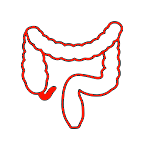
Laproscopic Appendicectomy
The appendix is a small, finger-shaped organ in the lower right side of the abdomen. It is linked to the large intestine and serves no purpose in humans. If your appendix must be removed, you will not experience any long-term complications.
Appendectomy is performed as an emergency procedure for appendicitis because the appendix has become inflamed (swollen) and must be removed. If it is not removed, it may burst and cause infection in the abdomen. A laparoscopic appendectomy is a minimally invasive surgery that removes the appendix through several small incisions rather than one large one.
Signs and symptoms of appendicitis may include:
- Sudden pain that begins on the right side of the lower abdomen
- Sudden pain that begins around your navel and often shifts to your lower right abdomen
- Pain that worsens with coughing, walking
- Nausea and vomiting
- Loss of appetite
- Low-grade fever that may worsen as the illness progresses
- Constipation or diarrhea
- Abdominal bloating
- Flatulence Tests and Treatment
Diagnosis
Before performing a Laparoscopic appendicectomy, the assessments are made through a couple of diagnostic tests, including:
- X-ray
- Abdominal Ultrasound
- MRI
- Blood Test Treatment
Laparoscopic appendectomy: This technique is less invasive. That is, it is performed without a large incision. Instead, one to three tiny cuts are made. A long, thin tube known as a laparoscope is inserted through one of the incisions. It includes a tiny video camera as well as surgical tools. The surgeon uses a TV monitor to guide the tools and see inside your abdomen. One of the incisions is used to remove the appendix. Because the incisions are small, there is less chance of bleeding or infection during and after surgery. Once again, due to the small size of the incision, post-operative pain is minimal.
Make an appointment right away for consultation on any signs and symptoms noticed
Call With Doctor